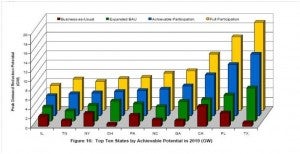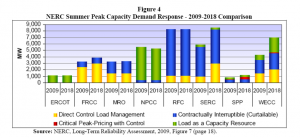Demand Response: A Key Component In Texas’ Electricity Market. Why Isn’t The State Taking Advantage Of It?
On Monday, the Texas Senate Business and Commerce Committee took up the critical issue of the impact of extreme drought conditions on electric generation capacity and state officials’ plans to respond to those risks. A number of important issues and policy solutions were raised, from on-bill financing of energy efficiency to renewable energy to send the right ‘market signals’ to incentivize the construction of new power plants. Public Utility Commission (PUC) Chair Donna Nelson singled out, in particular, the state’s energy efficiency and renewable energy goals. These policies have helped reduce pollution, saved customers money and have the added benefit of reducing our dependence on water for electricity production.
Another important part of the solution discussed was raised by a number of panelists: demand response (aka load management). The ability of end-use customers to reduce their use of electricity in response to power grid needs or economic signals has helped the Electric Reliability Council of Texas (ERCOT) avoid rolling blackouts and, in other regions of the country, it has helped markets avoid the need for new capacity. As ERCOT CEO Trip Doggett and PUC Chair Nelson pointed out in their testimony, demand response is a market competitive resource that uses no water and, as such, it may prove to be a valuable resource in view of the state’s record drought.
The Texas Capacity Crunch – Obstacles and Opportunities
The historic drought of 2010-2011 has put Texas’ conventional power plants at risk, threatening a return of the rolling blackouts caused by extreme winter conditions just a year ago. State Climatologist, Perry appointee John Nielsen-Gammon says, “Statistically we are more likely to see a third year of drought.”
At the same time, ERCOT faces a challenging capacity crunch caused largely by “low natural gas prices, an influx of low marginal cost wind power, increased wholesale market efficiencies, low wholesale power prices, tight credit markets” and other issues according to TXU Energy. With limited ability to invest new capital given the current market conditions, and over 11,000 MW of power dependent on water sources at historically low levels, Texas needs to tap into resources that can be deployed rapidly and require less capital and much less water.
Demand Response – Low Cost, Zero Water Resource
Fortunately Texas has ample resources to meet these needs with demand response. If allowed to participate fully in Texas’ energy markets as it does in other regions, demand response can benefit customers and increase grid reliability. Unfortunately Texas continues to lag behind other states and regions, which have seen market-competitive demand response grow rapidly as market barriers have been removed.
- The definition of “demand response” is “end-use customers reducing their use of electricity in response to power grid needs or economic signals from a competitive wholesale market.”
- The potential for cost competitive demand response is tremendous – according to the Federal Energy Regulatory Commission (FERC) Texas could add as much as 19 GW in capacity by 2019 if we open up our electric market to allow customers to compete alongside generators.
Texas currently is among the lowest states in terms of load management, despite having the highest potential by far according to FERC and the Brattle Group.

Why Does Texas Lag the Nation in Demand Response?
- In 2011, demand response amounted to 9% of the PJM’s (a grid operator in the Mid-Atlantic/Midwest) system peak demand, greatly benefitting customers and improving reliability.
- At ERCOT, despite great potential, demand response only amounted to just over 2% of peak demand, limited by unnecessary market barriers.
- Texas leads the nation in smart meter deployment, intended by the legislature to “facilitate demand response initiatives.” Why is ERCOT so far behind?
Market Barriers Prevent Customers from Competing in ERCOT
- ERCOT’s legacy demand response program is capped at 1150 MW and is effectively limited to large industrials within ancillary services markets.
- ERCOT’s Emergency Reliability Service is the only program in the market that allows any customer to participate if they qualify. The program is limited in scope (it can only be called on twice per year) and to date has been unable to reach the original goal of 500 MW. Despite these limitations, the program helped avoid rolling blackouts last summer.

Regulators are Focused on Building New Power Plants
- Instead of looking to all possible solutions, regulators seem focused only on how to get new power plants built.
- Other grid operators have successfully created programs for smaller commercial and residential customers to compete through aggregation. In Texas, residential and small commercial customers have been put on the back burner.
- Despite the PUC’s reluctance to act on other clean energy opportunities, such as the 500 MW non-wind RPS or increasing the energy efficiency standards, it is clear that these programs have been successful in creating clean, “water-proof” power.
- In the midst of a capacity crunch caused by extreme drought and market structure problems, demand response provides an opportunity to address both by enabling cheaper, water-free capacity by simply opening markets to customers.












One Comment
Regulators, utilities, and grid operators tend to think that demand response is for large industrial companies when in fact a more robust market is commercial buildings. The biggest contributor to peak demand comes from the air-conditioning of those buildings. Shifting the air conditioning load to night time generation can reduce a buildings demand by 10% – 30%. All of those commercial buildings in Texas saving reducing demand which can be used to defer construction of new plants while helping to create a load for all of the West Texas Wind Farms. Thermal Energy Storage (TES) used in hybrid cooling systems can also help ERCOT with grid stability and reliability.
TES has a a very good return on investment it is reliable and offers cooling system resiliency and flexibility. Combine that with the fact that the Edison Electric Institute (EEI) as said that the only source of energy, when converted to today’s dollars, that has not increased in 40 years is off peak electricity customers using these hybrid cooling systems have a great hedge against future cooling costs
Cheap fossil fuels made just in time manufacturing of electricity possible because the energy was stored in the fuel. Renewable energy will need to storage of all kinds to provide fossil fuels availability and flexibility. Adding DR into the mix just increases the value of storage to building and grid operators.
The Butterkrust renovation and a high school in San Antonio will have one of these hybrid cooling systems. So will the VA in Amarillo. TES is not sexy like solar panels or wind turbines, it just works. After 25 or mores years of service most systems can be refurbished or 99 % recycled.